INSTITUT SUPERIEUR D'ANTHROPOLOGIE
INSTITUTE OF ANTHROPOLOGY
ONLINE COURSES / COURS A DISTANCE
INSCRIPTION 2012 / Session III : Juillet 2012
REGISTRATION 2012 / Term III : July 2012
CHINE – 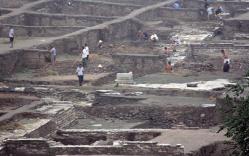 Tongzhou - Dongchengmen (the east gate) and Wengcheng (fortifications) of the ancient Tongzhou City were accidentally discovered during excavation for a new subway station, Xinhuadajie, in Beijing's Tongzhou district on July 9. Tongzhou City was a terminal station on the Grand Canal during the Ming and Qing Dynasties, and played a vital transportation and logistical support role throughout Chinese history. Officials acknowledge that the layout of Xinhuadajie Station and Beijing Metro Line 6 were to play an important part in the construction of Tongzhou New Town. At present, the on-site subway construction has already been suspended. One of the proposed solutions is to preserve the site at its current location, while another argues that the entire site should be temporarily relocated to make way for the metro station. Experts and relevant government departments are discussing how to best move forward.
Tongzhou - Dongchengmen (the east gate) and Wengcheng (fortifications) of the ancient Tongzhou City were accidentally discovered during excavation for a new subway station, Xinhuadajie, in Beijing's Tongzhou district on July 9. Tongzhou City was a terminal station on the Grand Canal during the Ming and Qing Dynasties, and played a vital transportation and logistical support role throughout Chinese history. Officials acknowledge that the layout of Xinhuadajie Station and Beijing Metro Line 6 were to play an important part in the construction of Tongzhou New Town. At present, the on-site subway construction has already been suspended. One of the proposed solutions is to preserve the site at its current location, while another argues that the entire site should be temporarily relocated to make way for the metro station. Experts and relevant government departments are discussing how to best move forward.
http://www.kaogu.cn/en/detail.asp?ProductID=3560
BULGARIE – Debelt - Golden medallions featuring inscriptions and images found in a gravesite dating to the Roman era in Debelt, a village in the region of Bourgas on Bulgaria’s Black Sea coast, have been identified by archaeologists as being from the second century CE. According to archaeologists, the graves are those of veterans of the eighth legion of Augustus. They are in the western part of the ancient Roman colony of Deultum, according to a report on July 17 2012 by public broadcaster Bulgarian National Television. Today the gravesite is next to a street in the latter-day village of Debelt. Deultum, in its time, was known as “Little Rome in Thrace”, the report said. The find was made by accident while people were pouring concrete for construction. The vibration of the concrete mixer caused the surface to crack and a tomb was found. Krasimira Kostova, director of the Archaeological Museum in Debelt, said that the find was of extremely high value. The valuable gifts were evidence that the people who lived there were of high status. The finds included golden jewellery and a needle, beads and scrapers used by the ancient Romans for bathing and massage and in medicine as a means of inserting medication in the ears and throat, the report said. All of these were signs of urban life in what was then an important place in the Roman empire.
http://sofiaglobe.com/2012/07/17/archaeology-golden-medallions-from-roman-era-found-in-village-near-bulgarias-bourgas/
PAKISTAN – 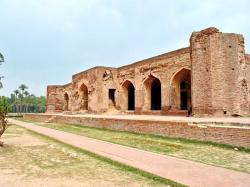
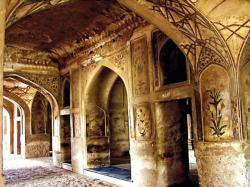 Lahore - The Archaeology Department plans to begin an extensive restoration project in a month or two for the tomb of 17th Century Mughal queen consort Nur Jahan, said officials. Nur Jahan’s resting place is located on 17 acres in Shahdara, close to the tomb of her husband Jahangir, and the tomb of her brother Asif Jah. Together with the Akbari Sirai, these monuments are clustered on a 107-acre site known as the Shahdara Complex. Malik said the walls, floors and domes of the monument were “terribly damaged”. Floral and geometric patterns lining the tomb’s domes have eroded, while the edges of the marble flooring have been chipped off, he added. The project will involve recreating the frescoes and restoring the red sandstone façade, walkways and surrounding gardens.
Lahore - The Archaeology Department plans to begin an extensive restoration project in a month or two for the tomb of 17th Century Mughal queen consort Nur Jahan, said officials. Nur Jahan’s resting place is located on 17 acres in Shahdara, close to the tomb of her husband Jahangir, and the tomb of her brother Asif Jah. Together with the Akbari Sirai, these monuments are clustered on a 107-acre site known as the Shahdara Complex. Malik said the walls, floors and domes of the monument were “terribly damaged”. Floral and geometric patterns lining the tomb’s domes have eroded, while the edges of the marble flooring have been chipped off, he added. The project will involve recreating the frescoes and restoring the red sandstone façade, walkways and surrounding gardens.
http://tribune.com.pk/story/409285/restoration-of-nur-jahans-tomb-to-begin-soon/
FRANCE – 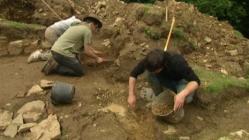 Altenberg - Début de chantier de fouilles dans l'Altenberg, aux dessus de Sainte-Marie-aux-mines. Pour la 7e fois l'association spéléologique pour l'étude et la protection des anciennes mines, l'Asepam, organise une série de chantier miniers. Objectif : mieux comprendre l'histoire des mines d'argent alsaciennes.
Altenberg - Début de chantier de fouilles dans l'Altenberg, aux dessus de Sainte-Marie-aux-mines. Pour la 7e fois l'association spéléologique pour l'étude et la protection des anciennes mines, l'Asepam, organise une série de chantier miniers. Objectif : mieux comprendre l'histoire des mines d'argent alsaciennes.
VIDEO = http://alsace.france3.fr/info/haute-alsace/alsace--fouilles-archeologiques-sur-l-altenberg-74867304.html
FRANCE – 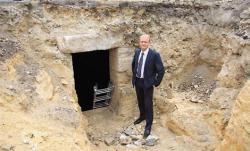 Argentan - En mai dernier, alors que le centre hospitalier entame les travaux d'installation de sa cuisine provisoire, devant l'accueil de l'hôpital, les pelleteuses découvrent un petit trou. Après avoir creusé autour et retiré les pierres bouchant l'entrée, les ouvriers réalisent qu'il s'agit d'un vieil édifice. « Cette installation ne préfigure pas sur le plan de 1850 de l'établissement », déclare le directeur Michel Renaut. Il s'agirait en fait d'une citerne, sorte d'ancienne réserve d'eau, datant du XVIIIe voire du XVIIe siècle ! Dans l'édifice, à même le sol, plusieurs bouteilles vides en très bon état ont été ramassées. D'après quelques recherches, elles dateraient de mi-XIXe et proviendraient d'un caniveau relié par une canalisation. Parmi ces trouvailles figure « le vin réparateur Auguet, très prescrit par la médecine de l'époque », indique Ghislain Martel, directeur des services économiques de l'hôpital, qui a retrouvé des articles évoquant le breuvage dans le journal L'Impérial (1884). Deux autres bouteilles ont pu être identifiées : l'Élixir de Guillié, un anti-glaireux, ainsi qu'un biberon. « Le site hospitalier est un site millénaire », précise Ghislain Martel. Construit en 1860, il compte un chapiteau, l'église et hôpital Dieu Saint-Thomas datant du XIIe, la résidence Saint-Jean, et une glacière. Cette dernière a d'ailleurs été découverte lors de la construction de l'extension en 2005.
Argentan - En mai dernier, alors que le centre hospitalier entame les travaux d'installation de sa cuisine provisoire, devant l'accueil de l'hôpital, les pelleteuses découvrent un petit trou. Après avoir creusé autour et retiré les pierres bouchant l'entrée, les ouvriers réalisent qu'il s'agit d'un vieil édifice. « Cette installation ne préfigure pas sur le plan de 1850 de l'établissement », déclare le directeur Michel Renaut. Il s'agirait en fait d'une citerne, sorte d'ancienne réserve d'eau, datant du XVIIIe voire du XVIIe siècle ! Dans l'édifice, à même le sol, plusieurs bouteilles vides en très bon état ont été ramassées. D'après quelques recherches, elles dateraient de mi-XIXe et proviendraient d'un caniveau relié par une canalisation. Parmi ces trouvailles figure « le vin réparateur Auguet, très prescrit par la médecine de l'époque », indique Ghislain Martel, directeur des services économiques de l'hôpital, qui a retrouvé des articles évoquant le breuvage dans le journal L'Impérial (1884). Deux autres bouteilles ont pu être identifiées : l'Élixir de Guillié, un anti-glaireux, ainsi qu'un biberon. « Le site hospitalier est un site millénaire », précise Ghislain Martel. Construit en 1860, il compte un chapiteau, l'église et hôpital Dieu Saint-Thomas datant du XIIe, la résidence Saint-Jean, et une glacière. Cette dernière a d'ailleurs été découverte lors de la construction de l'extension en 2005.
http://www.ouest-france.fr/actu/actuLocale_-Une-citerne-du-XVIIe-sous-le-sol-de-l-hopital-_-2096721------61006-aud_actu.Htm
LUXEMBOURG – 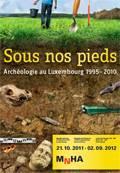 - Le Musée National d’Histoire et d’Art de Luxembourg (MNHA) propose, jusqu’au 2 septembre 2012, une exposition consacrée aux découvertes archéologiques réalisées au Grand-duché entre 1995 et 2010. De 1995 à 2010 de nombreux sites archéologiques ont été fouillés au Luxembourg. Différentes époques sont étudiées : préhistoire, antiquité et moyen âge. La première partie de l’exposition est consacrées aux différentes disciplines regroupées au sein de l’archéologie. En effet, les archéologues peuvent être céramologues, palynologues, architectes… Ils font aussi appels aux sciences exactes : biologie, chimie… L’exposition retrace aussi le parcours d’un objet entre sa mise au jour et sa présentation dans un musée. Ce parcours étant souvent méconnu, il est intéressant de s’y intéresser. Avec humour, les archéologues luxembourgeois évoquent aussi les préjugés qui entourent leur profession. Ensuite, plusieurs salles sont consacrées aux principales découvertes réalisées sur les dizaines de chantiers de fouilles ouverts par les chercheurs luxembourgeois. De nombreux objets sont visibles. On découvre également de superbes photos des sites majeurs : Titelberg, Dalheim (sud-est du Grand-duché)… De très belles maquettent permettent aussi de mieux comprendre l’habitat antique.
- Le Musée National d’Histoire et d’Art de Luxembourg (MNHA) propose, jusqu’au 2 septembre 2012, une exposition consacrée aux découvertes archéologiques réalisées au Grand-duché entre 1995 et 2010. De 1995 à 2010 de nombreux sites archéologiques ont été fouillés au Luxembourg. Différentes époques sont étudiées : préhistoire, antiquité et moyen âge. La première partie de l’exposition est consacrées aux différentes disciplines regroupées au sein de l’archéologie. En effet, les archéologues peuvent être céramologues, palynologues, architectes… Ils font aussi appels aux sciences exactes : biologie, chimie… L’exposition retrace aussi le parcours d’un objet entre sa mise au jour et sa présentation dans un musée. Ce parcours étant souvent méconnu, il est intéressant de s’y intéresser. Avec humour, les archéologues luxembourgeois évoquent aussi les préjugés qui entourent leur profession. Ensuite, plusieurs salles sont consacrées aux principales découvertes réalisées sur les dizaines de chantiers de fouilles ouverts par les chercheurs luxembourgeois. De nombreux objets sont visibles. On découvre également de superbes photos des sites majeurs : Titelberg, Dalheim (sud-est du Grand-duché)… De très belles maquettent permettent aussi de mieux comprendre l’habitat antique.
http://suite101.fr/article/decouvrez-lexposition--sous-nos-pieds--a-luxembourg-a34784
CANADA – Ile Saint-Barnabé - C’est la 4e année consécutive qu’une équipe est envoyée sur l’île qui fut la demeure du quasi légendaireToussaint Cartier, de 1728 à 1767. Manon Savard, professeure de géographie et d’archéologie, précise que les travaux qui ont été réalisés sur l’île Saint-Barnabé en 2009 et en 2010 ont permis de confirmer une présence amérindienne sur l’île. Les chercheurs ont découvert les vestiges d’un bâtiment rudimentaire et plusieurs artefactsqui témoignent d’occupations successives de l’île, du régime français jusqu’à la fin du XXe siècle.
http://www.lavantage.qc.ca/actualite/13-07-2012-les-fouilles-archeologiques-reprennent-sur-l-ile-saint-barnabe